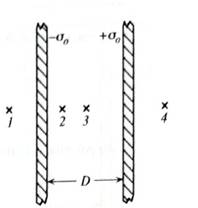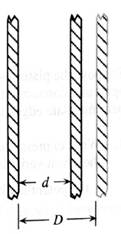
Concept explainers
The inner surface of one plate has a uniform charge density of

1. At each labeled point, draw vectors lo represent the electric field at that point due to each charged plate.
2. Write expressions for the following quantities in terms of the given variables:
•the electric field at points 1, 2, 3, and 4
• the potential difference between the plates
3. The right plate is moved to the left as shown. Both plates are kept insulated. Describe how each of the following quantities will change (if at all). Explain.
• the charge density on each plate
• the electric field both outside and between the plates

• the potential difference between the plates
4. Write expression for the following quantities in terms of
• the magnitude of the electric field between the plates
• the potential differences between the plates
5. Find
How, if at all, would this ratio change if the charge densities on the plates were
Learn your wayIncludes step-by-step video

Chapter 5 Solutions
Tutorials in Introductory Physics
Additional Science Textbook Solutions
College Physics: A Strategic Approach (3rd Edition)
Essential University Physics: Volume 2 (3rd Edition)
Modern Physics
Applied Physics (11th Edition)
Physics (5th Edition)
Physics: Principles with Applications
- Part A If a capacitor has opposite 5.0 µC charges on the plates, and an electric field of 1.9 kV/mm is desired between the plates, what must each plate's area be? Express your answer using two significant figures and include the appropriate units. Ti HẢ ? A = Value Unitsarrow_forwardA parallel-plate capacitor is constructed of two horizontal 18.0-cm-diameter circular plates. A 1.4 g plastic bead with a charge of -6.8 nC is suspended between the two plates by the force of the electric field between them. My Research Fo... Correct Part B What is the charge on the positive plate? Express your answer with the appropriate units. μA q= 1.61 10 6 C Submit Previous Answers Request Answer ? X Incorrect; Try Again; 9 attempts remainingarrow_forwardIn Configuration 1 below, what is the magnitude of the predicted electric field at point c? Point c is 3.00 m from the +3.00 nC charge (this is also in your lab procedure). Pt. a Pt. b Pt. c +3 nC figure 1 a Your answer should: Be in the Correct SI Units of N/C Be rounded to 3 Decimal Places For this problem you can't enter a number in Scientific Notation (the program doesn't allow it). For example: 2.06 x 10² would be written as 206.00arrow_forward
- Part A An electric dipole is formed from two charges, ±q, spaced 1.5 cm apart. The dipole is at the origin, oriented along the y-axis. The electric field strength at the point (x, y) = (0 cm, 10 cm) is 400 N/C. What is the charge q? Give your answer in nC. Express your answer in nanocoulombs. View Available Hint(s) nC Submit Part B What is the electric field strength at the point (æ, y) = (10 cm, 0 cm)? Express your answer with the appropriate units. • View Available Hint(s) НА E = Value Units %3Darrow_forwardNegative point charge q1 = -7.0x10-9 C is on the -x axis at -0.3m. Pasitive point charge q2=12x10-9 C is on xy plane as shown. 1.) What are the x and y components of the resultant electric field produced at point A by the two charges. indicate polarity. 2.) What is the net electric potential at point A due to q1 and q2?arrow_forwardDraw 2 objects of any shape (your choice) with one of the objects inside of the other. Be sure to consider symmetry. The objects don't have to be touching one another. The inner object is made of an insulating material while the outer object is made of a conducting material. 1. Draw a picture of your objects2. Define a charge on each object. The charge on the insulator must be uniformly distributed throughout the object (thus it must have a thickness)3. What is the charge on each surface of the conducting object?4. What is the electric field at the center of your insulating object? Explain5. What is the electic field a point inside your insulating object, but not at the center? Be sure to show on your diagram and in words (or equations) where you selected your point to be. Show your work. 6. What is the electric field at a point between your insulating and conducting objects? Be sure to identify the point on your figure and in words (or equations). Show your work. 7. What is the…arrow_forward
- a A capacitor is formed from two hemispheres with radii a and b (a < b). Assume that these two radii are very close to each other so that the following are valid approximations. • Charge on each hemisphere is distributed uniformly over the surface of the hemisphere. • The electric field between the hemispheres is radial and its magnitude depends only on the radial coordinate r. • The electric field outside the hemispheres is negligible. Suppose that when the capacitor is charged, the charge on the inner hemisphere is Q and the charge on the outer hemisphere is –Q. (a) Let E be the radial component of the electric field between the hemispheres for a point with radial coordinate r (aarrow_forwardConstants An electron is released from rest at a distance of 0.470 m from Part A a large insulating sheet of charge that has uniform surface charge density 2.90x10 C/m2 . How much work is done on the electron by the electric field of the sheet as the electron moves from its initial position to a point 2.00x10 2 m from the sheet? Express your answer with the appropriate units. HA ? W = Value Units Submit Request Answer Part B What is the speed of the electron when it is 2.00x102 m from the sheet? Express your answer with the appropriate units. HA Value Unitsarrow_forwardIn Configuration 1 below, what is the magnitude of the predicted electric field at point b? Point b is 2.00 m from the +3.00 nC charge (this is also in your lab procedure). Pt. a Pt. b Pt. c +3 nC figure 1 a Your answer should: Be in the Correct SI Units of N/C Be rounded to 2 Decimal Places For this problem you can't enter a number in Scientific Notation (the program doesn't allow it). For example: 2.06 x 102 would be written as 206.00arrow_forwardImage shows two plates with opposite charges. n represents the surface charge densities which are equal and opposite and seperated by a distance of d. Electron is launched from the positive plate with initial speed, vo. heading towards the negative plate. The electron stops just short of the negative plate. It then starts accelerating back to the positive plate. Calculate what n would be. Please show ALL work and make it detailed and neat. Vo +n -n d + + + + + +arrow_forwardTwo 11.0-cm-diameter electrodes 0.75 cm apart form a parallel-plate capacitor. The electrodes are attached by metal wires to the terminals of a 14 V battery. Part A What is the charge on each electrode while the capacitor is attached to the battery? Enter your answers separated by a comma. Express each answer using three significant figures. ▸ View Available Hint(s) 195) ΑΣΦΑ Q₁, Q₂ = Submit Part B Submit What is the electric field strength inside the capacitor while the capacitor is attached to the battery? Express your answer using three significant figures.. ▸ View Available Hint(s) 195] ΑΣΦΑ ? ? C V/marrow_forwardI Review | Constants The ammonia molecule (NH3) has a dipole moment of 5.0 x 10-30 C.m. Ammonia molecules in the gas phase are placed in a uniform electric field E with magnitude 1.4x106 N/C. Part A What is the change in electric potential energy when the dipole moment of a molecule changes its orientation with respect to E from parallel to perpendicular? Express your answer using two significant figures. ΑΣφ ? AU = Jarrow_forwardarrow_back_iosSEE MORE QUESTIONSarrow_forward_ios
 College PhysicsPhysicsISBN:9781305952300Author:Raymond A. Serway, Chris VuillePublisher:Cengage Learning
College PhysicsPhysicsISBN:9781305952300Author:Raymond A. Serway, Chris VuillePublisher:Cengage Learning University Physics (14th Edition)PhysicsISBN:9780133969290Author:Hugh D. Young, Roger A. FreedmanPublisher:PEARSON
University Physics (14th Edition)PhysicsISBN:9780133969290Author:Hugh D. Young, Roger A. FreedmanPublisher:PEARSON Introduction To Quantum MechanicsPhysicsISBN:9781107189638Author:Griffiths, David J., Schroeter, Darrell F.Publisher:Cambridge University Press
Introduction To Quantum MechanicsPhysicsISBN:9781107189638Author:Griffiths, David J., Schroeter, Darrell F.Publisher:Cambridge University Press Physics for Scientists and EngineersPhysicsISBN:9781337553278Author:Raymond A. Serway, John W. JewettPublisher:Cengage Learning
Physics for Scientists and EngineersPhysicsISBN:9781337553278Author:Raymond A. Serway, John W. JewettPublisher:Cengage Learning Lecture- Tutorials for Introductory AstronomyPhysicsISBN:9780321820464Author:Edward E. Prather, Tim P. Slater, Jeff P. Adams, Gina BrissendenPublisher:Addison-Wesley
Lecture- Tutorials for Introductory AstronomyPhysicsISBN:9780321820464Author:Edward E. Prather, Tim P. Slater, Jeff P. Adams, Gina BrissendenPublisher:Addison-Wesley College Physics: A Strategic Approach (4th Editio...PhysicsISBN:9780134609034Author:Randall D. Knight (Professor Emeritus), Brian Jones, Stuart FieldPublisher:PEARSON
College Physics: A Strategic Approach (4th Editio...PhysicsISBN:9780134609034Author:Randall D. Knight (Professor Emeritus), Brian Jones, Stuart FieldPublisher:PEARSON





